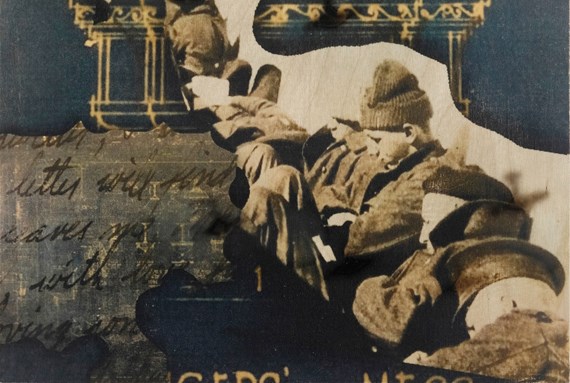Tracy McMenemy presents Songs of the Smoke, Nov. 10 to Dec. 4 at South Main Gallery, 279 E. 6th Ave., Vancouver. Opening reception: Nov. 10, 6-9 p.m. tracymcmenemy.com.
As a mixed-media artist, Tracy McMenemy has worked with many different materials. Only recently did she discover fire.
She wields a candle like a paintbrush, applying haunting billows of smoke to her wood panel. Holding the open flame against a stencil creates charcoal-black silhouettes of warplanes flying overhead.
“I discovered a way of using a candle and taking the soot from the burning candle and capturing it onto the wood,” explains the North Vancouver resident. “Once the soot’s on the image, then I take a paintbrush and I can actually manipulate the soot.”
McMenemy later learned this method, known as fumage, is an existing art technique that was popularized during the surrealist movement in the 1930s. Fumage features heavily in her new exhibit, Songs of the Smoke, which opens tonight at South Main Gallery in Vancouver. Smoke seemed an appropriate medium, since the show explores our collective memory of war.
It was a trip to the Seaforth Armoury on Burrard Street that set the project in motion. McMenemy initially visited the 1936 heritage building seeking blueprints. At the time, she was collecting architectural plans of Vancouver landmarks for use in her art.
“The armoury had always caught my eye because it’s such a stunning building,” she says.
While looking through the building plans, she also came across impressive electrical blueprints – “They had these gorgeous 1930s chandeliers.”
She got chatting with James Calhoun, archivist at the Seaforth Armoury Museum, who produced densely packed boxes of maps, photographs and artifacts from the First and Second World Wars. Calhoun regaled her with tales of the people who had donated these items.
“As he was telling me those stories, I was getting excited,” McMenemy recalls. She started to feel the energy behind each war medal and photo; they became more than just objects. “I just kept going back.”
Up to that point, McMenemy had considered wartime imagery scary and depressing.
“The way we were taught in school, it was so sanitized,” she says. It was about committing dates and names to memory. “There was never really that personal side to it.”
But as the lives of dozens of people emerged through black-and-white pictures and handwritten letters, she realized the story she wanted to tell through her art was about much more than Vancouver’s architectural history.
Her new series incorporate the artifacts and heirlooms she discovered at the museum. She took photographs of the old blueprints, maps and documents and transferred these images onto a wood panel. She then added ink or acrylic paint and employed the fumage technique. One of her pieces, “Home Away From Home,” juxtaposes blueprints of the palatial Seaforth Armoury with the rudimentary tents soldiers preparing for the First World War in Saanich, B.C. slept in. “Boys to Men” shows the faces of some of the first Canadian soldiers to travel overseas and fight in the First World War.
McMenemy describes Songs of the Smoke as a “collective memory” intended to allow people to revisit, reinterpret, and give new meaning to wartime.
“With the letters and the images, they’re coming from people’s personal photo albums that they donated to the archives,” she says. “That’s what really drew me in, is that it wasn’t so sanitized and boring, it was actual real people.”
She hopes the personal element allows gallery visitors to relate to her artworks. And, although war is a dark subject matter, the message she wishes to impart through her art is a positive one.
“It’s not something that everybody necessarily wants to look at, but I think if they see the beauty in the imagery it’s not as scary and I think it’s presented in a way that’s uplifting and beautiful,” she says.
“I hope that people realize how important it is to talk about our history and be connected to it, but in a good way.”



